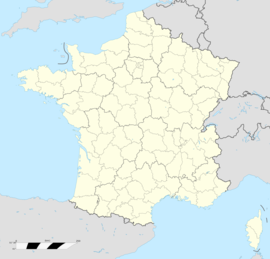سواسون
سواسون | |
|---|---|
 مبنى البلدية | |
| الإحداثيات: 49°22′54″N 3°19′25″E / 49.3817°N 3.3236°E | |
| البلد | فرنسا |
| المنطقة | أعالي فرنسا |
| الإقليم | إين (إقليم فرنسي) |
| الدائرة | سواسون |
| بينالتجمعات | Soissonnais |
| الحكومة | |
| • العمدة (2014-present) | Alain Cremont |
| المساحة 1 | 12٫32 كم² (4٫76 ميل²) |
| التعداد (2012) | 28٬309 |
| • الكثافة | 2٬300/km2 (6٬000/sq mi) |
| منطقة التوقيت | UTC+01:00 (CET) |
| • الصيف (التوقيت الصيفي) | UTC+02:00 (CEST) |
| INSEE/الرمز البريدي | 02722 /02200 |
| المنسوب | 38–130 m (125–427 ft) (avg. 55 m أو 180 ft) |
| 1 French Land Register data, which excludes lakes, ponds, glaciers > 1 km2 (0.386 sq mi or 247 acres) and river estuaries. | |
سواسون (Soissons ؛ النطق الفرنسي: [swa.sɔ̃]) هي بلدة في إقليم إين في پيكاردي في شمال فرنسا، تقع على نهر إين، على بعد 100 كم شمال شرق پاريس. وهي أحد أقدم البلدات في فرنسا، وربما تكون العاصمة القديمة المسماة سوِسون Suessiones. كما أن سواسون هي مقر الأبرشية الكاثوليكية القديمة/ التي يعود تاريخ تأسيسها إلى نحو عام 300.
التعداد
|
التاريخ
Soissons enters written history under its Celtic name, later borrowed into Latin, Noviodunum, meaning "new hillfort", which was the capital of the Suessiones. At Roman contact, it was a town of the Suessiones, mentioned by Julius Caesar (B. G. ii. 12). Caesar (B.C. 57), after leaving the Axona (modern Aisne), entered the territory of the Suessiones, and making one day's long march, reached Noviodunum, which was surrounded by a high wall and a broad ditch. The place surrendered to Caesar.
From 457 to 486, under Aegidius and his son Syagrius, Noviodunum was the capital of the Kingdom of Soissons,[1] until it fell to the Frankish king Clovis I in 486 after the Battle of Soissons.
Part of the Frankish territory of Neustria, the Soissons region, and the Abbey of Saint-Médard, founded in the sixth century, played an important political part during the rule of the Merovingian dynasty (447–751). After the death of Clovis I in 511, Soissons was made the capital of one of the four kingdoms into which his states were divided. Eventually, the kingdom of Soissons disappeared in 613 when the Frankish lands were amalgamated under Chlothar II.
The 744 Council of Soissons met at the instigation of Pepin the Short and Saint Boniface, the Pope's missionary to pagan Germany, secured the condemnation of the Frankish bishop Adalbert and the missionary Clement of Ireland.[2]
During the Hundred Years' War, French forces committed a notorious massacre of English archers stationed at the town's garrison, in which many of the French townsfolk were themselves raped and killed.[3] The massacre of French citizens by French soldiers shocked Europe; Henry V of England, noting that the town of Soissons was dedicated to the saints Crispin and Crispinian, claimed to avenge the honour of the saints when he met the French forces at the Battle of Agincourt on Saint Crispin's Day 1415. The town was liberated by French troops under the command of Joan of Arc on 23 July 1429.
Between June 1728 and July 1729 it hosted the Congress of Soissons an attempt to resolve a long-standing series of disputes between the Kingdom of Great Britain and Spain which had spilled over into the Anglo-Spanish War of 1727–1729. The Congress was largely successful and led to the signing of the Treaty of Seville between them.
During World War I, the city came under heavy bombardment. There was mutiny after the disastrous Chemin des Dames offensive at the Second Battle of the Aisne. A statue erected with images of French soldiers killed in action in 1917 is behind the St Peter's Church, next to the Soissons Courthouse.
المعالم
الكاتدرائية

انظر أيضاً
- Battle of Soissons
- Communes of the Aisne department
- الفرنجة
- List of Frankish Kings
- Merovingians
- Suessiones
- Vase of Soissons
- Wolf of Soissons
الهامش
- ^
 Chisholm, Hugh, ed. (1911). . دائرة المعارف البريطانية. Vol. 25 (eleventh ed.). Cambridge University Press. p. 352.
Chisholm, Hugh, ed. (1911). . دائرة المعارف البريطانية. Vol. 25 (eleventh ed.). Cambridge University Press. p. 352. {{cite encyclopedia}}: Cite has empty unknown parameter:|coauthors=(help) - ^ Dierkens, Alain (1984). "Superstitions, christianisme et paganisma à la fin de l'epoque mérovingienne: A propos de l'Indiculus superstitionem et paganiarum". In Hervé Hasquin (ed.). Magie, sorcellerie, parapsychologie. Brussels: Éditions de l'Université de Bruxelles. pp. 9–26.
- ^ G. A. Henty (1897). "Chapter XIX. Agincourt". At Agincourt. Archived from the original on 1 January 2019. Retrieved 2010-06-07 – via Classic Reader.
- This article incorporates text from the public domain Dictionary of Greek and Roman Geography by William Smith (1856).
وصلات خارجية
- Pages using gadget WikiMiniAtlas
- مقالات المعرفة المحتوية على معلومات من دائرة المعارف البريطانية طبعة 1911
- Short description is different from Wikidata
- Coordinates on Wikidata
- Pages using infobox settlement with image map1 but not image map
- Articles with hatnote templates targeting a nonexistent page
- Communes of Aisne
- عواصم أمم سابقة
- مراكز الدوائر الادارية في فرنسا
- Roman towns and cities in France
- صفحات مع الخرائط





